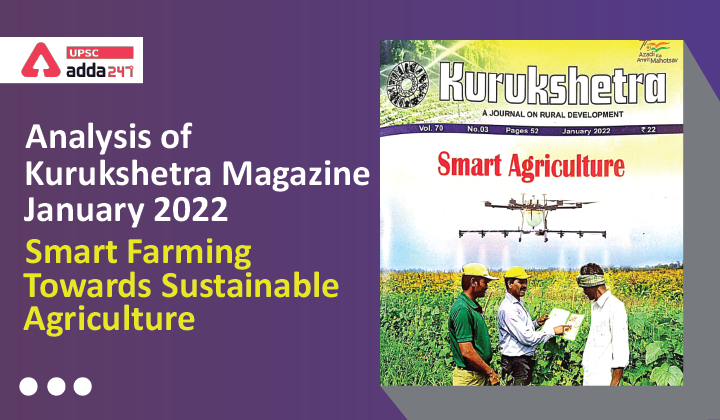Table of Contents
Relevance
”GS 3: Government Policies & Interventions, Agricultural Resources”
Introduction
- The Food and Agriculture Organisation (FAO) has estimated that the world population would reach 9.73 billion by 2050, and the increase will continue till it reaches 1l-.2 billion by 2100 (FAO, 2O!7). There are many challenges pertaining to restricted agricultural production like soil degradation through salinity, nutrient deficiencies, low soil organic carbon content, lower groundwater table, etc.
- The FAO first time defined climate-smart agriculture as an approach that transforms agri-food systems towards green and climate-resilient practices. It aims to tackle three main objectives: (i) sustainably increasing agricultural productivity and incomes; (ii) adapting and building resilience to climate change; and (iii) reducing and/or removing greenhouse gas emissions, wherever possible.
- According to the report of the Food and Agriculture Organization (FAO, 2OI7), about 20-40 per cent of crops are lost annually due to pests and diseases and as a result of lack of good monitoring system of the state of the crop.
- Hence the use of sensors and smart systems allows monitoring of weather factors, fertility status, and also determining the right number of fertilisers or pesticides necessary for crop growth.
What is Smart Farming?
• Smart farming is based on a precise and resource-efficient approach and attempts to achieve higher efficiency on agricultural production with increased quality and safety on a sustainable basis.
• However, from the farmers’ point of view, smart farming should provide added value in the form of more accurate and timely decision-making and more efficient exploitation operations and management.
• Smart farming technologies (SFTs) can be divided into three main categories: (i) farm management information systems (FMIS), (ii) precision agriculture (PA) systems, and (iii) agricultural automation and robotics.
• FMISs represent mainly software systems for collecting, processing, storing, and disseminating data in the form required to carry out a farm’s operations and functions. Smart farming also known as precision agriculture refers to the farming management concept aimed at optimising input use based on recording technologies to observe and measure inter-and intra-field spatial and temporal variability in crops, aiming to improve economic returns and reduce environmental impact.
• Precision agriculture is able to increase input efficiency for maintaining or even increasing production rate, using remote sensing technologies for data gathering with either satellite platforms for space imagery or aircrafts/UAVs for aerial applications, combined use of sensors for ground data acquisition, wireless networks for interconnecting them, geospatial data analytics coming from different sources, decision support systems (DSSs) for optimised farming decision-making, and others’.
• Agricultural automation and robotics are separate, but closely related ICT sectors’ They are interconnected to cover the process of applying automatic control, artificial intelligence techniques, and robotic platforms at all levels of agricultural production.
GOI’s Initiative
•The Government of India has formulated standard operating procedures (SoP) for use of drones for the purpose of spraying pesticides and fertilizers on agricultural crops. Drones can perform numerous functions that lead to improving agricultural practices.
• Government of India enhancing the use of Digital Technologies in agriculture to increase the overall efficiency of the agricultural production processes as well as the entire value chain.
• India’s National Strategy on Al also aims to realise the potential economic and social benefits the technology offers.
• Further, the National Strategy on Al recognises agriculture as one of the priority sector areas for implementation of Al driven solutions.
• lnformation technology-based farming system is also known by many names like digital agriculture/farming, precision agriculture, smart farming and Al in Agriculture.
Status of Smart Farming in India
- ‘Smart Farming’ in India is still an emerging concept that refers to managing farms using modern information and communication technologies like robotics, drones and Al to increase the quantity and quality of products while optimising the human labour required by production. These include variable-rate applicators, internet of things (loT), geo-positioning systems, big data, unmanned aerial vehicles UAVs (drones), automated systems, and robotics.
- However, attention toward smart farming is growing rapidly in lndia.
Benefits of Smart Farming
There are various applications of the use of digital technology in Agriculture. The advantages of smart farming can be summarised as follows:
(i) lncreasing the amount of real-time data on the crop;
(ii) Remote monitoring and controlling of farms;
(iii) Controlling water and other natural resources;
(iv) improving Livestock management;
(v) Accurate evaluation of soil and crops;
(vi) improving agricultural production; and
(vii) eco-friendly farming.Role of Sensor Technology.
The use of a sensor in Smart Farming?
- It is a device that produces an output signal for the purpose of sensing a physical phenomenon.
- ln the broadest definition, a sensor is a device, module, machine, or subsystem that detects events or changes in its environment and sends the information to other electronic systems, frequently a computer.
- In smart farming use of sensors play an important role in the precise application of inputs as per the demand to avoid losses and misuse. Sensors are responsible for measuring and monitoring all factors in the smart system.
Role of 5G Network in Smart Farming
There are many advantages of using a 5G network in smart applications as follows:- High data transfer capacity, low latency, Very high connection density compared to another network, Spectral efficiency improvement, Smooth communication performance, Extensive coverage, High efficiency of network energy.
Application of Smart Farming in Indian Context
- Locusts have been attacking and destroying large swathes of India’s crops on a regular basis since the winter months of 2019 and the attack is continuing. The Agriculture Ministries both at the central and the state levels have been using drones for anti-locust spraying.
- Drones are also used in irrigation, monitoring crop health, planting, crop spraying, crop inspection, and soil analysis.
- ln addition, the drone equipped with several sensors,3D cameras, thermal, multi-spectral, and optical imaging cameras can be used to monitor crop conditions and diseases, plant health indicators, vegetable density, pesticide prospecting, fertiliser use, canopy cover mapping, field prediction, plant count, plant height measurement, field water mapping, exploratory reports, nitrogen measurement.
- Furthermore, it can monitor the state of plants based on some vegetative indices that can be directly calculated by multi-spectral images, such as the Normalised Difference Vegetation Index (NDVI), which is considered very effective.
- Despite the many benefits of drone applications in agricultural operations, there are significant challenges that limit its use, especially in developing countries like India. Drones are expensive, especially those with good software, hardware tools, devices, high-resolution cameras, and thermal cameras.
- The drone can fly for a short time, reaching an hour or less; therefore, the flight line path must also be determined considering the overlap between the flight lines. Legal limitation of drone use needs permits for the operation due to security point of view. The operation of drones is affected by climatic conditions particularly wind speed and rains affect the drone performance, so the weather must be considered before using drones.
Use of Robotics in Agriculture
- To tackle labour shortages, agricultural robots are used to perform many agricultural practices.
- IOT has contributed to the development of robots to achieve multiple agricultural activities, where robots can perform many functions instead of humans. The use of such modern technology in agriculture facilitates improved agricultural efficiency, reduced operating costs and time.
- ln addition, the robots can reduce the environmental pollution of up to 80 per cent caused by farm’s pesticides.
- Agricultural robots can be practical tools to provide unconventional solutions to face labour shortages, especially in the case of the spread of pandemics like COVID-19.
What is Smart Decision Support Systems (SDSS)
- Smart Decision Support Systems (SDSS) in the agriculture sector aims to support farmers in making the proper decisions in irrigation management, fertilisation process, and others for service operations.
- ln addition, a decision support system have been proposed for irrigation management, as the system includes spatial location data and crop characteristics in terms of crop growth stages, planting date and water requirements, precipitation, temperature, as well as soil characteristics and water holding capacity.
- lt also includes an inference system that determines irrigation timing to maintain soil moisture within the appropriate limits; this system has positive impacts in terms of water use efficiency and quality of crop yield.
Challenges and opportunities
- The main challenge is the small landholdings, fragmented farms and the farmers are unable to adopt smart farming with limited knowledge and skills.
- Apart from these, there are many other challenges that also need to be improved to make smart farming a reality in India.
lnternet Connectivity is a challenge as Smart farming mainly relies on faster internet connectivity. - The bridge between farmers, smart communication device and field-based sensors for real-time information and management is still a challenge.
- GPS signal transmission is difficult in heterogeneous topography like hilly, forests and fields with dense tree planting.
- Data collection and processing centres and many IOT based sensors need uninterrupted and continuous energy for a successful application. Whereas, developing countries like India are already running out of energy resources. So, this may be a major hindrance for large scale adaptation of smart farms in near future.
Conclusion
The scenario for smart farming/digital agriculture is promising in India. Smart farming aims to increase production and improve the efficient use of land, water and other resources used in agriculture. Therefore, smart farming is the future facilitating better utilisation of precious resources, inputs and environmental protection. The key factors to succeed in smart farming in India are affordability of technology, ease of access and operations, easy maintenance of systems, timely grievance redressal and appropriate policy, support. Robust research and development in the field of smart farming are needed so that farming can empower Indian farmers to sustain their farm productivity and livelihood.



 TSPSC Group 1 Question Paper 2024, Downl...
TSPSC Group 1 Question Paper 2024, Downl...
 TSPSC Group 1 Answer key 2024 Out, Downl...
TSPSC Group 1 Answer key 2024 Out, Downl...
 UPSC Prelims 2024 Question Paper, Downlo...
UPSC Prelims 2024 Question Paper, Downlo...





